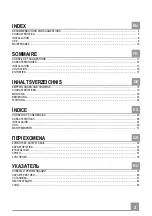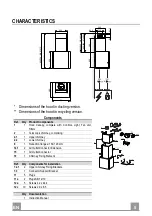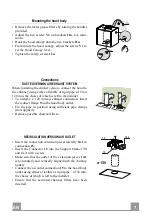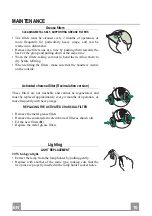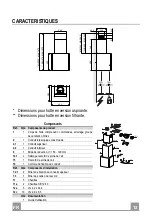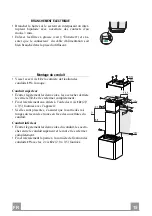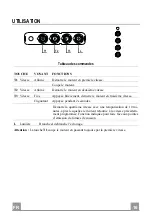
EN
4
4
RECOMMENDATIONS AND SUGGESTIONS
The Instructions for Use apply to several versions of this appliance. Accordingly, you may find
descriptions of individual features that do not apply to your specific appliance.
INSTALLATION
• The manufacturer will not be held liable for any damages resulting from incorrect or improper
installation.
• The minimum safety distance between the cooker top and the extractor hood is 650 mm (some
models can be installed at a lower height, please refer to the paragraphs on working dimensions
and installation).
• Check that the mains voltage corresponds to that indicated on the rating plate fixed to the inside of
the hood.
• For Class I appliances, check that the domestic power supply guarantees adequate earthing.
Connect the extractor to the exhaust flue through a pipe of minimum diameter 120 mm. The route
of the flue must be as short as possible.
• Do not connect the extractor hood to exhaust ducts carrying combustion fumes (boilers, fireplaces,
etc.).
• If the extractor is used in conjunction with non-electrical appliances (e.g. gas burning appliances), a
sufficient degree of aeration must be guaranteed in the room in order to prevent the backflow of
exhaust gas. The kitchen must have an opening communicating directly with the open air in order
to guarantee the entry of clean air.
When the cooker hood is used in conjunction with appliances
supplied with energy other than electric, the negative pressure in the room must not exceed 0,04
mbar to prevent fumes being drawn back into the room by the cooker hood.
• In the event of damage to the power cable, it must be replaced by the manufacturer or by the
technical service department, in order to prevent any risks.
• If the instructions for installation for the gas hob specify a greater distance specified above, this has
to be taken into account. Regulations concerning the discharge of air have to be fulfilled.
USE
• The extractor hood has been designed exclusively for domestic use to eliminate kitchen smells.
• Never use the hood for purposes other than for which it has been designed.
• Never leave high naked flames under the hood when it is in operation.
• Adjust the flame intensity to direct it onto the bottom of the pan only, making sure that it does not
engulf the sides.
• Deep fat fryers must be continuously monitored during use: overheated oil can burst into flames.
• Do not flambè under the range hood; risk of fire
• This appliance is not intended for use by persons (including children) with reduced physical, sen-
sory or mental capabilities, or lack of experience and knowledge, unless they have been given su-
pervision or instruction concerning use of the appliance by a person responsible for their safety.
• Children should be supervised to ensure that they do not play with the appliance.
• “ CAUTION: Accessible parts may become hot when used with cooking appliances.”.
MAINTENANCE
• Switch off or unplug the appliance from the mains supply before carrying out any maintenance
work.
• Clean and/or replace the Filters after the specified time period (Fire hazard).
• Clean the hood using a damp cloth and a neutral liquid detergent.
The symbol
on the product or on its packaging indicates that this product may not be treated as household waste. Instead it shall be handed over to the
applicable collection point for the recycling of electrical and electronic equipment. By ensuring this product is disposed of correctly, you will help prevent potential negative
consequences for the environment and human health, which could otherwise be caused by inappropriate waste handling of this product. For more detailed information
about recycling of this product, please contact your local city office, your household waste disposal service or the shop where you purchased the product
.
2°
Summary of Contents for Lithos EG6 BK A45
Page 1: ...Instructions Manual Manuel d Instructions Bedienungsanleitung Manual de instrucciones...
Page 3: ...EN 3 3 46 47 48 51 52 SA...
Page 32: ...GR 3 32 650 mm I 120mm 0 04 mBar 2...
Page 36: ...GR 3 36 3 mm 4 12c 19 7 2 1 4 12c 2 9 x 9 5 19 2 12c 2 9 x 9 5...
Page 37: ...GR 3 37 T2 T1 L T3 LED T1 T2 T3 2 10 L T1...
Page 38: ...GR 3 38 2 4 A B A B 20 W...
Page 39: ...RU 3 39 650 I 120 0 04 2...
Page 41: ...RU 4 41 373 105 150 150 12a 650 7 2 1 1 2 7 2 1 X X 105 8 11 12a 4 2 x 44 4 7 3 373 150 12 11a...
Page 42: ...RU 4 42 Vr 11a 2 11a Vr 12 150 120 120 9 150 9 120 14 1 15 15 7 3 14 1 15 150 15 150 14 1 7 3...
Page 43: ...RU 4 43 3 4 12c 19 7 2 1 4 12 2 9 x 9 5 19 2 12 2 9 x 9 5...
Page 44: ...RU 4 44 T2 T1 L T3 T1 T2 T3 2 10 L T1...
Page 45: ...RU 4 45 2 4 A B 20...
Page 46: ...SA 4 46 650 a 120 0 04 2...
Page 48: ...SA 4 48 373 105 150 150 12a 650 7 2 1 1 2 7 2 1 X X 105 8 11 12a 4 2 x 44 4 7 3 373 150 12 11a...
Page 50: ...SA 5 50 19 4 12c 7 2 1 4 12 c 2 9 x 9 5 19 2 12 c 2 9 x 9 5...
Page 51: ...SA 5 51 T2 T1 L T3 T1 T2 T3 2 10 L T1...
Page 52: ...SA 5 52 4 A B A B 20...
Page 53: ......
Page 54: ......
Page 55: ......
Page 56: ...436005912_ver2...


